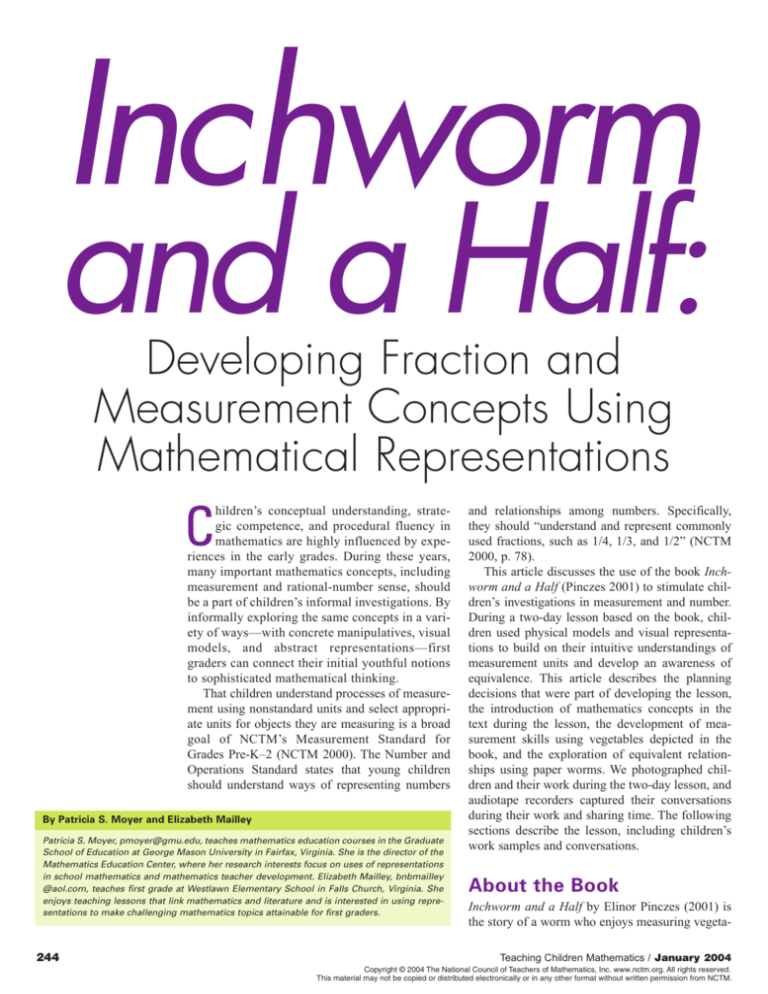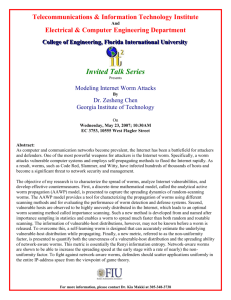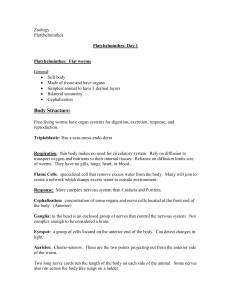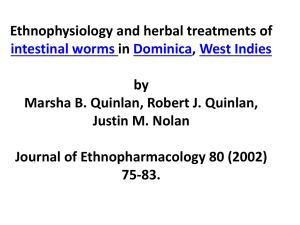
Inchworm
and a Half:
Developing Fraction and
Measurement Concepts Using
Mathematical Representations
hildren’s conceptual understanding, strategic competence, and procedural fluency in
mathematics are highly influenced by experiences in the early grades. During these years,
many important mathematics concepts, including
measurement and rational-number sense, should
be a part of children’s informal investigations. By
informally exploring the same concepts in a variety of ways—with concrete manipulatives, visual
models, and abstract representations—first
graders can connect their initial youthful notions
to sophisticated mathematical thinking.
That children understand processes of measurement using nonstandard units and select appropriate units for objects they are measuring is a broad
goal of NCTM’s Measurement Standard for
Grades Pre-K–2 (NCTM 2000). The Number and
Operations Standard states that young children
should understand ways of representing numbers
C
By Patricia S. Moyer and Elizabeth Mailley
Patricia S. Moyer, pmoyer@gmu.edu, teaches mathematics education courses in the Graduate
School of Education at George Mason University in Fairfax, Virginia. She is the director of the
Mathematics Education Center, where her research interests focus on uses of representations
in school mathematics and mathematics teacher development. Elizabeth Mailley, bnbmailley
@aol.com, teaches first grade at Westlawn Elementary School in Falls Church, Virginia. She
enjoys teaching lessons that link mathematics and literature and is interested in using representations to make challenging mathematics topics attainable for first graders.
244
and relationships among numbers. Specifically,
they should “understand and represent commonly
used fractions, such as 1/4, 1/3, and 1/2” (NCTM
2000, p. 78).
This article discusses the use of the book Inchworm and a Half (Pinczes 2001) to stimulate children’s investigations in measurement and number.
During a two-day lesson based on the book, children used physical models and visual representations to build on their intuitive understandings of
measurement units and develop an awareness of
equivalence. This article describes the planning
decisions that were part of developing the lesson,
the introduction of mathematics concepts in the
text during the lesson, the development of measurement skills using vegetables depicted in the
book, and the exploration of equivalent relationships using paper worms. We photographed children and their work during the two-day lesson, and
audiotape recorders captured their conversations
during their work and sharing time. The following
sections describe the lesson, including children’s
work samples and conversations.
About the Book
Inchworm and a Half by Elinor Pinczes (2001) is
the story of a worm who enjoys measuring vegetaTeaching Children Mathematics / January 2004
Copyright © 2004 The National Council of Teachers of Mathematics, Inc. www.nctm.org. All rights reserved.
This material may not be copied or distributed electronically or in any other format without written permission from NCTM.
Photograph by Patricia S. Moyer; all rights reserved
Planning the Lesson
Many resources exist for teachers to use in planning a mathematics lesson that uses a children’s
book (Burns 1992; Griffiths and Clyne 1988). During several brainstorming sessions, we discussed
possible mathematics topics and appropriate extensions that could be taught with the text. We noted
that in addition to measuring vegetables, the
worms in the story also represent different fractional amounts in relationship to one another.
Because the text combines both measurement and
fraction concepts, we decided to address each concept in a two-part lesson. Day one would focus on
arbitrary or nonstandard-length measurement and
Teaching Children Mathematics / January 2004
Photograph by Patricia S. Moyer; all rights reserved
bles in a garden. She measures hot peppers, pole
beans, and eggplants, singing, “Squirmy, wormy,
hoopity-hoop! I measure everything, loopity loop”
(p. 4). The worm measures happily until one day
when the unthinkable happens: She discovers that
she cannot accurately measure a cucumber that is
two worm lengths and a little bit more. Luckily a
worm half her size appears, and together they are
able to measure the cucumber.
As the book progresses, worms one-third her
size and one-fourth her size join in the measuring,
and together the four worms (1 whole worm, 1/2
worm, 1/3 worm, and 1/4 worm) are able to measure all the vegetables in the garden. The text is
written in a lyrical style, and the illustrations by
Randall Enos, particularly the facial expressions of
the worms, make the book inviting and enjoyable
for young children who can predict what will happen next in the story.
day two would focus on equivalent fractional relationships. Prior to the introduction of operations
(addition, subtraction, multiplication, and division)
with fractions in subsequent grades, children in
first grade explore fraction concepts such as equivalent fractions in the context of measurement that
involves nonstandard or standard units. In previous
lessons, the children used several different nonstandard length measurements. They explored nonstandard measuring devices such as paper clips,
chain links, and Unifix cubes as referents for measuring classroom objects. These experiences taught
them important concepts about aligning the measuring device with the object they were measuring.
This group of first graders also had previous experience with concrete and pictorial representations
245
Figure 1
The paper cut-outs the children used
and set and region models using fractions. They
had some general knowledge about fractional
quantities and were familiar with how to write a
fraction. Representations that connect abstract
ideas with visual and physical models help bring
these challenging concepts within a first grader’s
reach.
Our ideas for day one came directly from the
content of the book: The worms in the text were
measuring vegetables, so we decided to introduce
the measurement concepts by having the children
measure vegetables as well. To prepare for the first
part of the lesson, we gathered vegetables, created
a vegetable recording sheet, and designed paper
worms based on the worms in the book. The children would measure real vegetables using paper
cut-outs that represented, both in appearance and
relational size, the cartoon-character worms from
the story (see fig. 1). These paper worms could be
used individually or together to measure the
lengths of different vegetables.
Children’s early experiences with fractions
often focus on region models because they are easier for children to learn. Unfortunately, some
246
teachers do not move beyond this basic model for
fractions, and they overlook other models. For
example, introducing the measure interpretation of
fractions (Kieren 1980) is one way to help children
understand concepts involving the density of the
rational numbers. Children understand the density
of rational numbers when they are able to perform
partitions other than halving, identify fractions
between two given fractions, and use given unit
intervals to measure any distance from the origin
(Lamon 1999). Therefore, we chose to develop and
use fractional models for length measurement by
representing the different lengths of the worms in
the story: 1 whole worm, 1/2 worm, 1/3 worm, and
1/4 worm.
In addition to exploring the concept of length
measurement, the book’s dialogue compares the
fractional relationships of the worms’ sizes. For
example, the half-inch worm compares himself to
the one-whole worm when he says, “At just half
your size, I’m a one-half-inch fraction, you see.”
The illustration verifies this comment, helping the
reader both see and verbalize the relationship
between the two worms. We wanted children to
Teaching Children Mathematics / January 2004
focus on these comparisons between the lengths of
the worms while we also introduced ideas of fractional relationships. Therefore, we designed day
two’s lesson so that children could manipulate and
compare the paper-worm cut-outs to find sets of
equivalent values, then use abstract representations
to record these findings on construction paper.
Figure 2
Vegetable worksheet for recording measurements
Exploring Mathematical
Concepts in the Text
On both days, the teacher began the mathematics
activities by reading the story to the children. As
she read the text, she asked questions that encouraged children to examine the mathematics in the
story. Her questions prompted the children to
examine the relationships among the worms and
make comparisons. For example, when the text
showed the whole worm compared to the one-half
worm, the teacher asked, “What do you notice
about these two worms?” and “How many of these
[worms] would you need to make one of those?”
She asked questions that helped the children think
about the lengths of the vegetables, such as “Can
anyone tell how long this leaf is that she measured
by looking at how many loops she made?” and
“Why do you think they couldn’t finish measuring
the carrot?” The teacher also asked questions that
helped children look for patterns. For example,
after the one-half and one-third worms appeared,
the teacher asked the children to predict the fractional measurement of the next worm.
Reading the book prompted interesting questions and conversations from the children. At one
point in the story, when one of the worms said,
“My length’s one-third-inch on the dot” (p. 19), a
child asked, “How come he’s a dot?” The teacher
used this opportunity to develop the children’s
vocabulary by addressing concepts and expressions of precision (such as on the dot) that relay
ideas about measurement. Other children made
observations such as “On the cover it has different
kinds of names, but it should be called The Fraction Worms” and “They’re making a worm chain.”
Another child wanted to know, “What’s an asparagus spear?” These comments demonstrated that
the children were making observations, predictions, and generalizations from the text and illustrations that included and went beyond measurement and fractional concepts. The exchanges
between the teacher and the children built on their
curiosity and were an important bridge to the next
part of the lesson.
Teaching Children Mathematics / January 2004
Using Paper Worms as
Nonstandard Length
Models
After the teacher finished reading the story on the
first day, she showed the students examples of
some of the different vegetables in the book and
named each one. She told the children that they
would be measuring vegetables just as the worms
in the story had done. The teacher showed the children paper cut-outs of 1 whole worm, 1/2 worm,
1/3 worm, and 1/4 worm. The children were familiar with these symbolic representations from previous lessons, and the teacher’s comparison of the
paper worm strips reinforced their understanding
of the fractional relationships among the worm
lengths. For example, she asked the children to
compare the length of two one-half worms to the
one-whole worm and to find other combinations of
worms that might make a one-whole worm. She
also asked the children to compare which worms
were larger or smaller and displayed the different
worms as examples. She was careful to point out to
the children that their paper worms were not called
“inchworms” because they were much bigger than
one inch.
While the children sat with the teacher in a circle on the floor, the teacher modeled how to mea247
sure a stalk of celery using the paper worms. She
demonstrated how to measure the celery by lining
up the end of the paper worm with the end of the
stalk of celery. One child suggested that the teacher
start with the one-whole worm to begin the measurement because, she explained, “It’s almost as
big as the celery.” The teacher then asked, “Can
this worm measure the celery all by itself?” The
children replied, “No.” After the teacher and the
children experimented by adding the one-fourth
worm to the one-whole worm, they determined that
the stalk of celery was about one and one-fourth
worms long. The teacher measured a carrot as
another example for the children, and she showed
them how to record the measurements on the vegetable worksheet. She also explained that not all
the vegetable measurements would be exact but the
children should use the closest measurement that
they could find.
When the children returned to their table
groups, the teacher gave each of them a vegetable
worksheet to record their measurements (see
fig. 2). The following vegetables were in the center
of each table group: a stalk of celery, a carrot, an
asparagus spear, a green bean, a cucumber, and a
zucchini. The children began to use the worms to
measure the vegetables (see fig. 3). On their vegetable worksheets, they drew pictures of each vegetable next to the vegetable’s name and recorded
their measurements.
Prior to this lesson, we discussed how the children might record the worm lengths when they
combined different fractional amounts to measure
a vegetable. For example, how would they record a
measurement when they used a one-half worm and
a one-fourth worm to measure a carrot? We
decided that we wanted to see what strategies the
Figure 3
Photograph by Patricia S. Moyer;
all rights reserved
Using the worms to measure the
vegetables
248
Figure 4
Many students recorded two fractional lengths
side by side.
children would devise for recording these measurements, so we did not give them specific instructions on this part of the task. Although teacherprovided representations are important during
instruction for learning the conventional aspects of
representation (such as fractional symbols), allowing student-generated representations can enhance
and deepen the meaning of fractions and other
mathematics concepts for young children (Lamon
2001).
Throughout the lesson, the children were careful to measure from one end of the vegetable to the
other, and they often tested worms of different
lengths to determine which would give them the
most accurate measurements. Most of the children
recorded the fractional amounts using the word
worm as a label for their numbers. When they used
two fractional lengths together, such as 1/4 and 1/2
or 1/4 and 1/3, almost all of them wrote the two
fractions side by side (see fig. 4). One student,
however, used addition signs to join the two fractional amounts (see fig. 5). Another child combined
1/3 and 1/3 and wrote “2/3 worm” for the measurement of the carrot, and he also used the word
about to show that the measurement was approximate (see fig. 6). The children appeared to develop
meaning for these numbers through their own
Teaching Children Mathematics / January 2004
interactions with the length models and their interpretations of how to record the measurements.
After the children measured the vegetables, the
teacher called them together as a group to share
their measurements with one another. Because
young children frequently possess much greater
knowledge than they are able to express in writing,
the sharing and discussion that follow their investigations are an important part of extending their
learning. During their discussions on the first day,
the students recognized that they were using different measurements for the same vegetables, so the
teacher led a class discussion about reasons for
these different results. The students conjectured
that some vegetables might be different sizes at different table groups and that using paper worms was
not a precise measurement, only an approximate
measurement. They also talked about why some of
the children’s answers looked different when written as symbols, although they were actually the
same length amounts. For example, the teacher
compared one child’s answer of 1/2 with another
child’s answer of 1/4 and 1/4 by using the one-half
and one-fourth worms to compare the lengths.
Continuing the comparison, the teacher asked the
children if another way existed to write 1/4 and 1/4
so that they were combined. One of the children
said, “You could have said it was two-fourths.” The
teacher summed up this discussion by saying, “Any
of these are correct because the bean does measure
one-half worm, the bean does measure one-fourth
plus one-fourth, and we know that one-fourth and
one-fourth is two-fourths so it measures twofourths also.” The teacher finished the lesson on the
first day by recording examples of the children’s
measurements and showing them how they could
put an addition sign between the fractional
amounts to show that the two numbers were combined. These ideas led into the lesson on day two.
Exploring Equivalent
Relationships
On the second day, the teacher read the story to the
children again. After the measurement activities of
the first day, her questions and the children’s comments included new ideas about measurement concepts that the book presented. For example, because
they had measured vegetables with the paper
worms, the children now were able to verbalize
measurement lengths more accurately. At the point
in the book at which the inchworm and the one-half
inchworm measure the beet together, the teacher
Teaching Children Mathematics / January 2004
Figure 5
Jacky used addition signs to record the
measurements.
pointed to the one-whole and one-half worms and
asked, “If this beet is one of these worms and one
of these worms long, how long is the whole beet?”
The children responded, “One and a half.” The
teacher pointed out phrases in the book, such as
“For every loop made by the inchworm, the shorter
worm had to make two” (p. 16), and asked what the
statements meant. This encouraged the children to
look at the relationships between the lengths of the
worms. In this example, discussion focused on the
one-half inchworm making two loops for every one
loop made by the inchworm.
The teacher revisited ideas from the previous
day when children’s measurements were written
using different numbers, such as the “one-fourth
plus one-fourth” or “one-half” or “two-fourths”
measurement for the bean. She introduced the
word equivalent to describe the equivalent values
the children would be writing during day two and
asked them to think of another word in mathematics that was similar to equivalent. Although the
children were only in first grade, one perceptive
child offered the word congruent as a similar word
and another child suggested equal. Next, the
teacher showed the students the one-whole paper
worm and asked them to find another worm or
worms that were equivalent to the one-whole
249
Figure 6
Nick combined fractions and noted
approximations.
Figure 7
Student 1. Try to do this one. This one is hard.
Student 2. But you know what? We can always
use another one.
Student 1. Yeah, but that’s gonna be too big.
Finding equivalent sets
worm, noting, “I want them to be equal in length.”
One of the children suggested “two halves,” so the
teacher used two of the one-half worms, placing
them end to end above the one-whole worm on her
chart board to show that two of the one-half worms
were as long as a one-whole worm. The teacher
and the children discussed how they might record
that the length of the one-whole worm and the
length of two half worms was the same. The children realized that they could use addition and
250
equals signs to show this relationship. They determined that 1/2 worm plus 1/2 worm equals 1 whole
worm, so the teacher wrote 1/2 + 1/2 = 1 on the
chart paper. The teacher told the children that when
they returned to their desks, they would find three
sets of the worms and a large piece of construction
paper on each desk. Their task was to use the paper
worms to find four different sets of equivalent
lengths and then write the corresponding equation
to represent the relationships they found.
When they found sets of worms that were
equivalent, such as three one-third worms and a
one-whole worm, they glued these worms end to
end and placed one set above the other on their
construction paper. Then they recorded their equations (in this case, 1/3 + 1/3 + 1/3 = 1) on the paper
below the worms (see fig. 7). At one table, children were excited when they found an equivalent
value: “Look! Those match! Look!” They even
experimented with the new mathematical language that the teacher had taught them as one
child repeated, “Equivalent! E . . . quivalent! E . . .
quivalent!” As the following exchange shows, the
children also were using problem-solving and estimation strategies:
Several children verbalized aloud as they wrote
their equations on the construction paper. Examples of these verbalizations to others at the table or
to the teacher included “One-third plus one-third
plus one-third is one whole,” “One-fourth plus onefourth equals one-half,” and “One-fourth plus onefourth plus one-half equals one whole.” Through
these articulations, the students explored the names
for equivalent values, and their written equations
and the paper worms served as representations of
their work.
Most of the children represented the following
equations:
1/2 + 1/2 = 1
1/4 + 1/4 = 1/2
1/4 + 1/4 + 1/4 + 1/4 = 1
1/3 + 1/3 + 1/3 = 1
About one-third of the children represented the
equation as 1/4 + 1/4 + 1/2 = 1 (see fig. 8). Other
equations were more unique; only one or two chilTeaching Children Mathematics / January 2004
During this class session, none of the children
made the common errors that students usually make
when calculating the addition of fractions, such as
adding both the numerators and denominators to get
the incorrect equation of 1/2 + 1/4 = 2/6. Children
did not make these typical errors because we did
not ask them to add the fractional symbols; instead,
we asked them to use the equals sign to show an
equivalent relationship among the paper worms.
The focus was on equivalence and relationships
among the worms, rather than on performing a calculation. For first graders, the ability to express a
fractional relationship in the form of an equation at
this level of complexity would have been unlikely
without the use of the paper worms as representations. Although these concepts will be developed
more deeply in the upper elementary grades, this
early experience gave meaning to the rational numbers that the students were using and served as an
introduction to important concepts about equivalence for later mathematical development.
At the end of these investigations, the teacher
called the children together as a group so they
could share their equations with one another. The
teacher recorded the children’s number sentences
on chart paper (see fig. 9). During their sharing, the
children’s comments showed the foundations of
many important mathematical principles. For
example, as one child observed the equations that
the teacher recorded, she commented, “One-half
equals one-fourth plus one-fourth, and one-fourth
plus one-fourth equals one-half,” revealing an
important perception about equivalence. Another
child’s comment became a catalyst for discussing
the concept of balancing equations and equivalence. She said to the teacher, “After she puts the
equals sign, she shouldn’t put any more. It should
be her answer.” This led to a discussion with the
children about what the equals sign indicates in a
number sentence and how the worms that the children compared were equal in length. During the
discussion, the teacher held up student papers as
visual models to explain this complex idea. They
discussed that the equals sign is not a marker to
show that an answer is coming but an indicator that
Teaching Children Mathematics / January 2004
One student’s representation of the
equation
Figure 9
The students’ number sentences
Photograph by Patricia S. Moyer; all rights reserved
1/2 + 1/4 + 1/4 = 1/3 + 1/3 + 1/3
1/3 + 1/3 + 1/3 = 1/2 + 1/2
1/4 + 1/4 + 1/4 + 1/4 = 1/3 + 1/3 + 1/3
1/4 + 1/4 + 1/4 = 1/2 + 1/4
Figure 8
Photograph by Patricia S. Moyer;
all rights reserved
dren represented them. Examples of these included
the following:
both sides of the equation represent a value that is
the same. This foundational understanding of
equivalence is essential for students’ later success
in the study of algebra.
Reflections
Although most first-grade children cannot use symbolic representations alone to compare fractions
251
with unlike denominators, using the measure interpretation of fractions (Kieren 1980) and its corresponding representations enabled these children to
effectively make those comparisons. This method
of interpreting fractions built on and extended principles of measurement with which the children
were familiar. In this lesson, children learned how
to choose a fractional unit that provided the most
precise measurement, how to use several different
fractional amounts to measure one object, and how
to record fractions as units of measurement. Many
other ways exist for teachers to foster the development of rational-number sense using the measure
interpretation of fractions. That a unit of measure
can always be divided up into smaller sub-units for
a more precise measurement reading is an important concept to develop. Children can use number
lines, rulers, or liquid containers and locate fractions between two numbers on the measuring
instrument to develop this skill. Classroom activities—such as the successive partitioning of number
lines, areas, and volumes—can connect these mathematical ideas in flexible ways and support the
future study of the density of numbers and rational
numbers as arbitrary divisions of a unit.
Fractions are relational numbers—that is, they
express mathematical relationships between two
discrete or continuous quantities—and are cognitively complex for students to learn. The paper
worms supported the children as they generated
new ideas about these concepts and laid their foundational understanding of equivalence. In this lesson, children learned how to use mathematical
symbols to record an equivalent relationship, combined fractions to equal one whole, and used the
equals sign to show an equivalent relationship
rather than an answer. Frequent and varying opportunities for recognizing and creating equivalent
representations for the same number help give children a broad and deep foundation for meanings and
operations with rational numbers.
Fractional benchmarks such as 1/2, 1/3, and 1/4
are integral to children’s development of rationalnumber sense. Understanding that different interpretations of fractions exist—from part-whole
comparisons and measures to operators, quotients,
and ratios and rates—further contributes to children’s robust understanding of the rational numbers (Kieren 1980). Ultimately, the ability to compare fractions leads to greater facility with
proportionality, or the ability to think flexibly
about quantities and their relationships. Using a
variety of representations in different mathematical
situations supports the sense-making process and
the development of these connections, furthering
children’s mathematical thinking and building their
understanding of number relationships.
References
Burns, Marilyn. Math and Literature (K–3): Book One.
Sausalito, Calif.: Math Solutions Publications, 1992.
Griffiths, Rachel, and Margaret Clyne. Books You Can
Count On: Linking Mathematics and Literature.
Portsmouth, N.H.: Heinemann, 1988.
Kieren, Thomas E. “The Rational Number Construct: Its
Elements and Mechanisms.” In Recent Research on
Number Learning, edited by T. E. Kieren, pp.
125–49. Columbus, Ohio: ERIC-SMEAC, 1980.
Lamon, Susan J. Teaching Fractions and Ratios for
Understanding. Mahwah, N.J.: Erlbaum, 1999.
———. “Presenting and Representing: From Fractions
to Rational Numbers.” In The Roles of Representation in School Mathematics, edited by A. A. Cuoco
and F. R. Curcio, pp. 146–65. Reston, Va.: National
Council of Teachers of Mathematics, 2001.
National Council of Teachers of Mathematics (NCTM).
Principles and Standards for School Mathematics.
Reston, Va.: NCTM, 2000.
Pinczes, Elinor J. Inchworm and a Half. Boston:
Houghton Mifflin Company, 2001. ▲
252
Teaching Children Mathematics / January 2004







